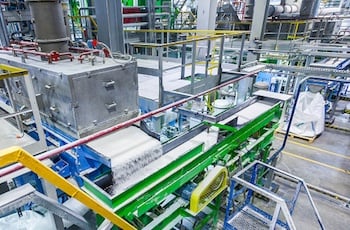Nigeria’s manufacturing sector’s contribution to the Gross Domestic Product (GDP) has witnessed a significant contraction over the past two quarters, reflecting a decline of 20.95% from the end of 2023 to the second quarter of 2024.
According to the National Bureau of Statistics (NBS) reports, the sector’s contribution to GDP fell from 16.04% in Q4 2023 to 12.68% in Q2 2024, highlighting the sector’s increasing struggles amid the country’s economic challenges.
This progressive decline over the first half of 2024 underscores the sector’s vulnerabilities, particularly in the face of ongoing economic and infrastructural challenges.
What is the data saying
The Q4 2023 report indicated a manufacturing sector contributing 16.04% to the GDP, showcasing the sector’s substantial role in Nigeria’s economy.
However, this contribution sharply declined in Q1 2024 to 14.79%, marking the beginning of a downward trend that has culminated in a further drop to 12.68% by Q2 2024.
The manufacturing sector’s nominal GDP growth in the second quarter of 2024 was recorded at 1.91% year-on-year. This represents a significant decline of 27.99%-points compared to the 29.90% growth recorded in the corresponding period of 2023.
Moreover, it marks a 6.30%-point decrease from the 8.21% growth registered in the first quarter of 2024. On a quarter-on-quarter basis, the sector experienced a contraction of 11.25% during Q2 2024.
The nominal GDP growth rate is crucial as it represents the monetary value of all goods and services produced by the manufacturing sector without adjusting for inflation.
The sluggish growth in nominal terms indicates that the sector is struggling to expand its output, and this stagnation could have far-reaching implications for employment, investment, and overall economic stability in Nigeria.
The manufacturing sector’s contribution to nominal GDP in Q2 2024 was 12.68%, down from 14.55% in Q2 2023 and lower than the 14.79% recorded in Q1 2024.
When examining the real GDP growth and the sector’s contribution to overall GDP, the manufacturing sector’s performance presents a concerning picture.
Real GDP growth in the manufacturing sector, which adjusts for inflation, provides a clearer view of the sector’s actual production levels and economic value.
The real GDP growth in the manufacturing sector also reflects the sector’s ongoing struggles. In Q1 2024, real GDP growth for the manufacturing sector was 1.49% year-on-year, a slight improvement over the previous quarter, with a contribution to overall GDP of 9.98%.
However, by Q2 2024, real GDP growth had further declined to 1.28%, which is lower than both the growth recorded in Q2 2023 and the preceding quarter.
The quarter-on-quarter growth rate in Q2 2024 stood at -15.16%, a significant drop from the 1.74% quarter-on-quarter growth observed in Q1 2024.
The sector’s real contribution to GDP in Q2 2024 was 8.46%, down from 8.62% in Q2 2023 and also lower than the 9.98% contribution recorded in Q1 2024.
What you should know
Despite its diverse activities spanning food, oil refining, beverages, and tobacco, textiles, and cement production, the manufacturing has struggled to maintain its previous levels of output and contribution.
Odiri Erewa-Meggison, the Chairman of the Export Promotion Group within the Manufacturers Association of Nigeria (MAN), recently said that the current period is the most challenging in the history of the manufacturing sector.
The Manufacturing Association of Nigeria (MAN) further reported a concerning trend within the industry, revealing that about 767 manufacturing companies shut down operations while 335 experienced distress in 2023. This development was attributed to various economic difficulties, including exchange rate volatility, rising inflation, and a general worsening of the investment climate.
These adversities have taken a toll on the manufacturing sector, significantly impacting its performance and sustainability.
Nigeria’s Gross Domestic Product (GDP) experienced a year-on-year growth of 3.19% in real terms during the second quarter of 2024. The GDP growth rate surpasses the 2.51% recorded in the second quarter of 2023 and the 2.98% growth seen in the first quarter of 2024.
However, this growth does not translate to an improvement in the manufacturing sector, which is still struggling.
The manufacturing sector’s struggles are reflective of broader economic issues, including challenges in power supply, access to finance, and infrastructural deficiencies, which have impeded the sector’s productivity and growth potential. Also, the persistent inflationary pressures and currency volatility have exacerbated these challenges, leading to reduced consumer demand and higher production costs.
Earlier this year, MAN projected a tough start for the manufacturing sector in 2024 but anticipated improvements towards the third quarter.
The Director General of the group, Mr. Segun Ajayi-Kadir, said that the prospect of recovery relies heavily on implementing policy stimuli and a synthesis of domestic growth through export-focused and trade strategies.
This approach is expected to enhance resilience, foster steady growth, and ensure the sector gains significant traction in the latter part of the year.
Investment and Advisory firm, Comercio partners, has said that Nigerians should be cautions with the rising GDP growth rate.
The firm expressed concern over the slowdown in non-oil sector growth compared to Q2 2023, particularly within manufacturing and agriculture, indicating potential vulnerabilities.
It noted that addressing the downward trends in agriculture and manufacturing is essential for achieving balanced and inclusive economic growth.
Source:norvanreports.com

